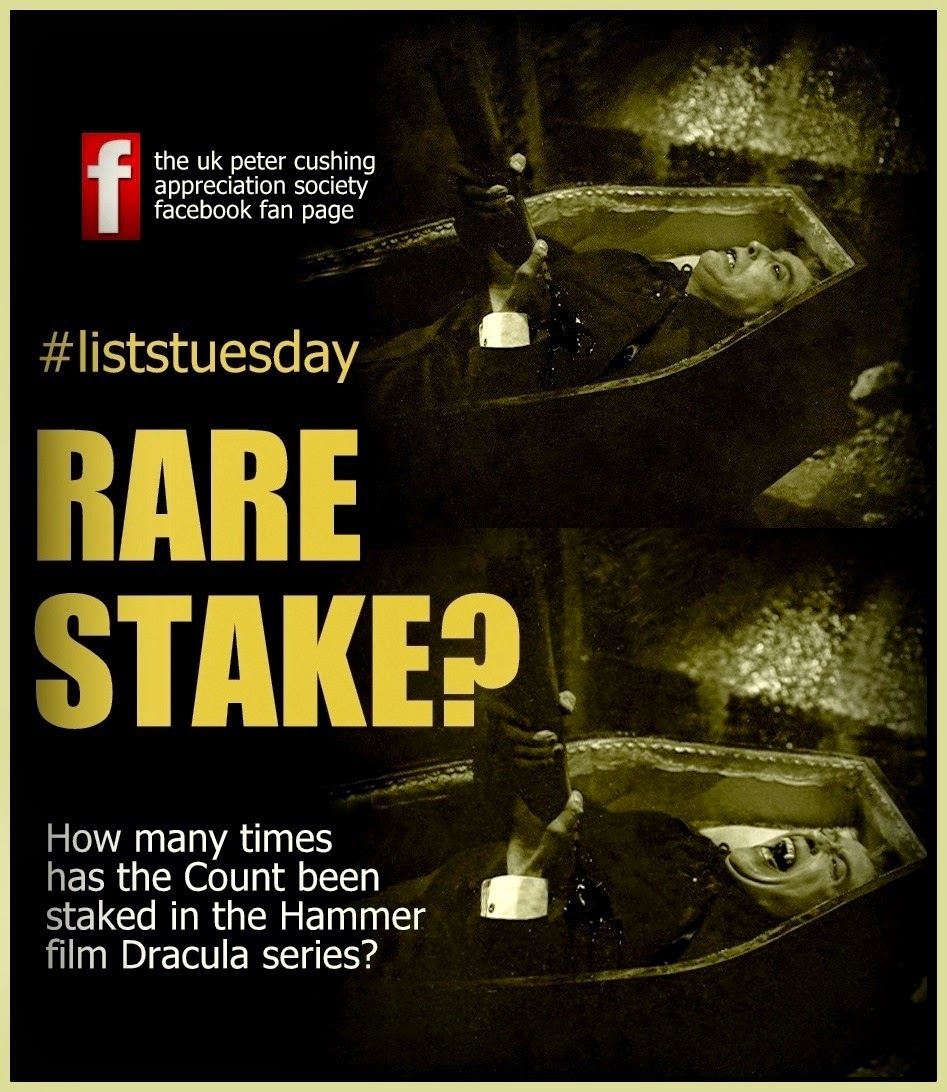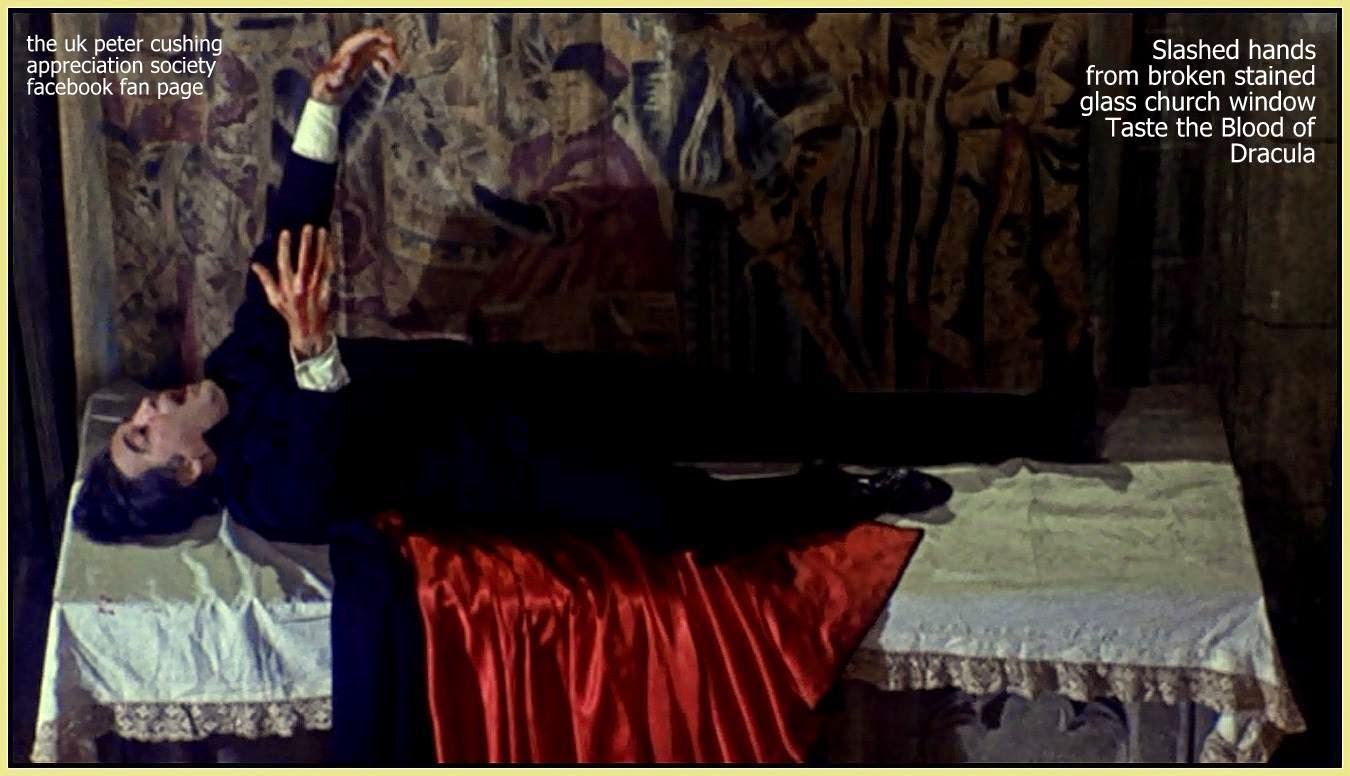Today, fifty six years ago, the camera turned on the first day of production of Hammer Films 'DRACULA' (US: HORROR OF DRACULA) at BRAY STUDIOS.
CAST:
Peter Cushing (Dr Van Helsing), Christopher
Lee (Count Dracula), Michael Gough (Arthur Holmwood), John Van Eyssen
(Jonathan Harker), Melissa Stribling (Mina Holmwood), Carol Marsh (Lucy
Holmwood), Valerie Gaunt (Vampire Woman)
PRODUCTION:
Director – Terence Fisher, Screenplay –
Jimmy Sangster, Based on the Novel by Bram Stoker, Producer – Anthony
Hinds, Photography – Jack Asher, Music – James Bernard, Special Effects –
Syd Pearson, Makeup – Phil Leaky, Art Direction – Bernard Robinson.
Production Company – Hammer Films
SYNOPSIS:
Posing as a librarian, erstwhile vampire
hunter Jonathan Harker travels to Castle Dracula where he is welcomed
by the courtly Count Dracula. Harker attempts to kill Dracula and
eliminate the vampire menace that Dracula spreads but the sun sets
before he can do so. Jonathan’s body and diary are found by his friend
Dr Van Helsing who stakes him and takes the sad news on to his fiancée
Lucy Holmwood. There Van Helsing finds that Lucy has become Dracula’s
prey. Joined by her brother Arthur, Van Helsing begins a search for
Dracula, to stake and kill him before Lucy is fully claimed as a
vampire.
COMMENTARY:
Dracula – usually better known under its American retitling, The Horror of Dracula – is the cornerstone of the Hammer Films legend. Although The Curse of Frankenstein (1957) the year before was beginning of Hammer’s success, The Horror of Dracula
was the one that set Hammer on the map and marked the beginning of
Hammer’s domination over the horror scene for the next fifteen years. The Horror of Dracula’s
status, certainly in Anglo-horror fandom, is sacrosanct and its
importance near mythic. The essence of what the Hammer film was all
about is here – the darkly magnetic presence and aristocratic
haughtiness of Christopher Lee; the commanding, straight-arrow
rationalism of Peter Cushing; the florid shock hand of director Terence
Fisher; the essential British repressions of sexuality and convention
that Anglo-horror would pierce a stake right through; and the laughably
dated shocked critical outcry.
Where then to view The Horror of Dracula
today? Hammer films, particularly the early ones, have not dated well.
Today their pace seems slow; the shocks that caused such a critical
outcry (and then quickly transformed into the expected mainstay of this
particular genre) seem absurdly mannered, even laughable. The rich and
floridly colourful sets seem flat and stagebound and James Bernard’s
celebrated scores loud and unsubtle. Yet The Horror of Dracula
holds undeniable effect. One must understand exactly what it
represented to audiences back then. To an audience raised on the Bela
Lugosi Dracula (1931) and the cardboard, melodramatic figure that Dracula became among the Universal monsters line-up in the 1940s, The Horror of Dracula
must have had an incredible shock value. For one, it was in colour –
which meant that one could see the blood in its rich, overripe scarlet
detail – and that alone made it an immediately different film to the
Bela Lugosi version. For another, it was not as stagebound as the Lugosi
version – Terence Fisher’s camera is kinetic and alive, always on the
move.

As an attempt at adapting Bram Stoker’s Dracula (1897), The Horror of Dracula
is never any better or worse than any other version. Screenwriter Jimmy
Sangster liberally sacrifices parts here and there for the economy of
plot and budget – out go Renfield and the asylum (although these later
appeared in Hammer’s Dracula – Prince of Darkness
[1966]). Gone too is the magnificently ambient opening journey to
Castle Dracula, the pursuit climax and set-pieces like the crashing of
the Demeter. Gone too is Dracula as a supernatural being – “It is a
common fallacy,” says Van Helsing, “that vampires can change into bats
and wolves,” which conveniently does away with having to create costly
effects sequences. (Although said fallacy seemed to have been disproven
by the time of later sequels). Despite the liberties he takes with Bram
Stoker, Jimmy Sangster nevertheless preserves the essence of the book.
The remarkable sexual element present in
the Bram Stoker book (wherein Dracula essentially became a sexual
predator, plundering the prim, virginal heroines and turning them into
sexually aggressive and irresistible creatures), which was only
fleetingly touched on in the Lugosi Dracula,
is clearly brought out here – Mina sits up in bed in a V-neck nightgown
that does a remarkable job of holding in more than one would ever think
possible with her window open waiting for Dracula, and at other points
the women invitingly tilt their necks up in anticipation. “It is
established victims consciously resent being dominated by vampirism but
are unable to resist the practice,” Van Helsing states. The Bela Lugosi
version bled the film and its women dry of any sexual vitality but here
Dracula had well and truly emerged from the Victorian closet. Part of
the shock value that The Horror of Dracula had was its very wantonness in this regard.

In person, Dracula was 6’5” Christopher
Lee. Christopher Lee incarnated Dracula as a haughty, imposing nobleman
(in real life Lee traces his ancestry back to the Emperor Charlemagne).
Bela Lugosi was a puffed-up ham, all stuffed-shirt menace; Christopher
Lee, going back to the Stoker book, is introduced as a perfect gentleman
who with shock rapidity turns into a ravening animal. When this Dracula
is enraged, he is an animal, hissing, his eyes turning scarlet red. Not
even Bram Stoker managed to show Dracula with this kind of raw
lasciviousness. On the side of good was Peter Cushing who makes the
definitive Van Helsing. Thankfully gone is the Dutch accent that Stoker
gave Van Helsing and Peter Cushing is able to bring his customary
genteel and commanding authority to the role. There is no greater sense
in cinematic vampire mythology of Van Helsing as a man of reason who
sits astride both science and religion with equal ease, holding society
safe against primal forces than there is in Peter Cushing’s performance.

Most of all, The Horror of Dracula
belongs to Terence Fisher who subsequently became Hammer’s most
prominent director and developed a considerable critical cult within
genre fandom. Fisher has no time for Bram Stoker’s Romantic imagery (or
even subtlety) and heads straight for shock effect with all guns
blazing. There is a shock scene where Valerie Gaunt tries to sink her
teeth into Jonathan’s neck as he comforts her, only to be interrupted as
Christopher Lee bursts in through a door – in this moment, Terence
Fisher shock-cuts to a closeup of Lee’s face, eyes wide-open, blazing
blood red and two trails of blood dripping from his fangs, and then has
him leap across a table to throw both of them aside. The climax offers a
stunning battle between the forces of light and darkness and is an
indelible image in horror film – Van Helsing pursues Dracula into the
library and leaps across a table to rip the curtains open, exposing an
area of sunlight, then jumps on a table and grabs two candelabra to form
a cross, which he uses to drive Dracula into the beam of sunlight,
causing him to crumble into dust that is then blown away by a mysterious
gust of wind as the end credits roll. It is a set-piece that even
outstrips the climax in the book.
Other adaptations of Dracula are:– the silent classic Nosferatu (1922); Dracula (1931); Count Dracula (1970) a continental production that also featured Christopher Lee; Dracula (1974), a tv movie starring Jack Palance; Count Dracula (1977), a BBC tv mini-series featuring Louis Jourdan; Dracula (1979), a lush remake starring Frank Langella; Nosferatu the Vampyre (1979) with Klaus Kinski; Francis Ford Coppola’s Bram Stoker’s Dracula (1992), featuring Gary Oldman; the Italian-German modernized adaptation Dracula (2002) starring Patrick Bergin; Guy Maddin’s silent ballet adaptation Dracula: Pages from a Virgin’s Diary (2002); Dracula (2006), the BBC tv adaptation starring Marc Warren; the low-budget modernised Dracula (2009); and Dario Argento’s Dracula (2012) with Thomas Kretschmann as Dracula.
Terence Fisher’s other genre films are:– the sf films The Four-Sided Triangle (1953) and Spaceways (1953), The Curse of Frankenstein (1957), The Revenge of Frankenstein (1958), The Hound of the Baskervilles (1959), The Man Who Could Cheat Death (1959), The Mummy (1959), The Stranglers of Bombay (1959), The Brides of Dracula (1960), The Two Faces of Dr Jekyll (1960), The Curse of the Werewolf (1961), The Phantom of the Opera (1962), The Gorgon (1964), Dracula – Prince of Darkness (1966), Frankenstein Created Woman (1967), The Devil Rides Out/The Devil’s Bride (1968), Frankenstein Must be Destroyed (1969) and Frankenstein and the Monster from Hell (1973), all for Hammer. Outside of Hammer, Fisher has made the Old Dark House comedy The Horror of It All (1964) and the alien invasion films The Earth Dies Screaming (1964), Island of Terror (1966) and Night of the Big Heat (1967).
Jimmy Sangster’s other genre scripts are:– X the Unknown (1956), The Curse of Frankenstein (1957), The Revenge of Frankenstein (1958), The Man Who Could Cheat Death (1959), The Mummy (1959), The Brides of Dracula (1960), the psycho-thrillers A Taste of Fear/Scream of Fear (1961), Paranoiac (1962), Maniac (1963), Nightmare (1963), Hysteria (1965) The Nanny (1965) and Crescendo (1970), and Dracula – Prince of Darkness (1966), all for Hammer. Sangster’s non-Hammer scripts are the medical vampire film Blood of the Vampire (1958), the alien invasion film The Trollenberg Terror/The Crawling Eye (1958), Jack the Ripper (1959), the Grand Guignol psycho-thriller Who Slew Auntie Roo? (1971), the tv movie psycho-thrillers A Taste of Evil (1971) and Scream, Pretty Peggy (1973), the occult tv movie Good Against Evil (1977), the occult film The Legacy (1979), the spy tv movies Billion Dollar Threat (1979) and Once Upon a Spy (1980), the psycho-thriller Phobia (1980) and the story for Disney’s The Devil and Max Devlin (1981). As director, Sangster made three films:– The Horror of Frankenstein (1970), the lesbian vampire film Lust for a Vampire (1971) and the psycho-thriller Fear in the Night (1972), all at Hammer
Images and Banner: Marcus Brooks
























